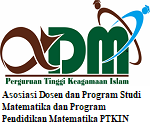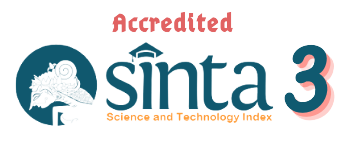| Supported by: |
AUTHOR GUIDELINES
The general guideline for authors
Manuscript preparation:
- To meet journal writing standards, submitted manuscripts shall at least contain; Title, abstract, introduction, methods or preliminaries, result and discussion, conclusion, and
- The title clearly describes the research substance with a maximum of 20 words
- The article must include abstract in Indonesian and English and be following by the keywords (3-5 words). Abstract and keywords are typed in single-spaced and Times New Roman 10 pts.
- The manuscript is written in English, which consists of 2500 up to a maximum of 7000 words.
- The manuscripts are arranged in A4 size paper format, with one column. Wide margin 4 cm (left) and 3 cm (top, bottom, and right)
- The article must be typed in single-spaced, Times New Roman font with size 11pts except for abstract
- The citation must be in form of in-text and bibliography are based on IEEE style.
- References are typed in single-spaced and TNR 11pts. The authors are encouraged to use journals as the main references and avoid using web articles. The bibliography must be the last 10 years of publication except for any foundational works.
Article Template
To help authors in fulfilling the requirement of article organization in the journal, Author Template is available. It can be used directly to write articles. Article template English
Article Format
The Title of Manuscript
(Times New Roman, 14pt Bold, Space 1, center alignment)
Author’s Name[1], Author’s Name[2], Author’s Name[3]
(TNR, 12pt Bold, center alignment)
[1] Institution, email@institusi.ac.id (TNR, 10 pts)
[2] Institution, email@institusi.ac.id
[3] Institution, email@institusi.ac.id
Abstrak: Abstrak harus memberikan gambaran yang jelas terkait konten artikel. Isi abstrak harus memuat pendahuluan, metode yang digunakan, hasil penelitian dan diskusi, dan simpulan. Abstrak ditulis dengan sepanjang 100-200 kata. Jenis huruf yang digunakan adalah Times New Roman dengan ukuran 10 dan spasi 1. Abstrak ditulis dalam bahasa Indonesia dan Inggris.
Kata kunci: Panduan abstrak, Matematika (Italic, 3-5 kata)
Abstract: The Abstract should describe clearly the content of the article. It includes an introduction, methods, results and discussion, and conclusion. An abstract is written in 100-200 words. The font used for abstract is Times New Roman 10 pts with single spacing. The abstract must be in Indonesian and English.
Keywords: Abstract guideline, Mathematics (Italic, 3-5 words)
1. Introduction ← 11pts, TNR bold
(10 pts TNR; space 1)
Provide an adequate background supported with adequate literature reviews. State the objectives of the work. This should not be more than three pages in general.
2. Methods ← 11pts, TNR bold
(10 pts TNR; space 1)
Provide sufficient details research methods to allow the work to be reproduced by an independent researcher. Methods that are already published should be summarized and indicated by a reference. Any modifications to existing methods should also be described.
Numbering format in this journal article should be as follows:
a. Figures
The figures must be arranged as an example below

Figure 1. Jurnal Matematika MANTIK logo (TNR, 10 pts)
b. Equations
Equations should be numbered serially within parentheses as shown in Equation (1). The equations must use equation feature in Microsoft Word, not an image. The equation number is to be placed at the extreme right side. The equation should be numbered as follows:

c. Tables
The tables must be written in space 1 and 10 pts. The table format used in this journal article is as below.
3. Results and Discussion ← 11pts, TNR bold
(10pts TNR; space 1)
Results should be clear and concise, and be part of a single section, discussing the significance of the results of the work, not repeat them. The discussion should be supported by adequate citation of the published literature.
4. Conclusions← 11pts, TNR bold
(10pts TNR; space 1)
The main conclusions drawn from results should be presented in a short. Avoid repetition as previously stated in the abstract, for example. The conclusion is written in the form of a descriptive paragraph (one to three paragraphs), not as the numbering.
5. Acknowledgment ← 11pts, TNR bold
(10pts TNR; space 1)
Acknowledgment is optional. The author/s is encouraged to acknowledge any parties that give a contribution to the research. It is not the same as the dedication chapter in the thesis/dissertation.
References ← 11pts, TNR bold
(10 pts, TNR, space 1)
Guideline for bibliography in Jurnal Matematika MANTIK is as follows:
- Minimum 15 references for each article, 80% of them are primary references from reputable journal papers with their DOI or URLs.
- The references must be the last 10 years
- The authors are highly encouraged to use reference apps such as Mendeley, Zotero, EndNote, and others
- The references apply IEEE styles.
Examples of bibliography and citation
Reference must use IEEE with a citation manager such as Mendeley, Endnote, Zotero, etc. The template will number citations consecutively within brackets [1]. The sentence punctuation follows the bracket [2]. Refer simply to the reference number, as in [3], do not use “Ref. [3]” or “reference [3]” except at the beginning of a sentence: “Reference [3] was the first ...”
Number footnotes separately in superscripts. Place the actual footnote at the bottom of the column in which it was cited. Do not put footnotes in the abstract or reference list. Use letters for table footnotes.
Unless there are six authors or more give all authors’ names; do not use “et al.”. Papers that have not been published, even if they have been submitted for publication, should be cited as “unpublished” [4]. Papers that have been accepted for publication should be cited as “in press” [5]. Capitalize only the first word in a paper title, except for proper nouns and element symbols.
For papers published in translation journals, please give the English citation first, followed by the original foreign-language citation [6].
[1] G. Eason, B. Noble, and I. N. Sneddon, “On certain integrals of Lipschitz-Hankel type involving products of Bessel functions,” Philos. Trans. R. Soc. London. Ser. A, Math. Phys. Sci., vol. 247, no. 935, pp. 529–551, 1955.
[2] J. C. Maxwell, A treatise on electricity and magnetism, vol. 1. Clarendon Press, 1881.
[3] I. S. Jacobs, “Fine particles, thin films, and exchange anisotropy,” Magnetism, pp. 271–350, 1963.
[4] K. ELISSA, “Title of paper if known.” unpublished.
[5] R. Nicole, “Title of paper with only first word capitalized,” J. Name Stand. Abbrev, vol. 2, pp. 740–741, 1987.
[6] M. Young, The technical writer’s handbook: writing with style and clarity. University Science Books, 2002.







.png)




